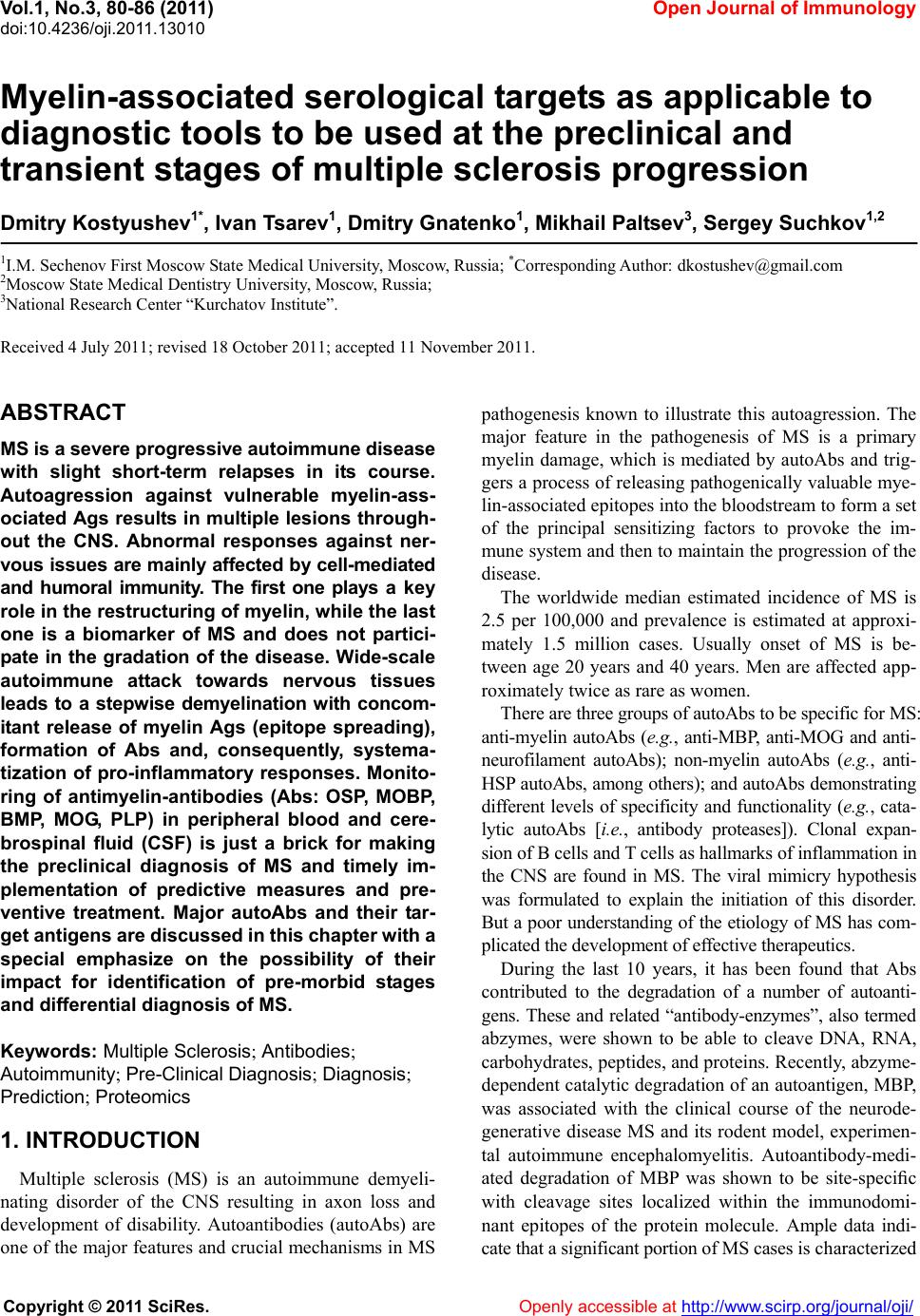 Vol.1, No.3, 80-86 (2011) doi:10.4236/oji.2011.13010 C opyright © 2011 SciRes. Openly accessible at http://www.scirp.org/journal/oji/ Open Journal of Immunology Myelin-associated serological targets as applicable to diagnostic tools to be used at the preclinical and transient stages of multiple sclerosis progression Dmitry Kostyushev1*, Ivan Tsarev1, Dmitry Gnatenko1, Mikhail Paltsev3, Sergey Suchkov1,2 1I.M. Sechenov First Moscow State Medical University, Moscow, Russia; *Corresponding Author: dkostushev@gmail.com 2Moscow State Medical Dentistry University, Moscow, Russia; 3National Research Center “Kurchatov Institute”. Received 4 July 2011; revised 18 October 2011; accepted 11 November 2011. ABSTRACT MS is a sev ere progr essi ve autoimmune disease with slight short-term relapses in its course. Autoagression against vulnerable myelin-ass- ociated Ags results in multiple lesions through- out the CNS. Abnormal responses against ner- vous issues are mainly affected b y cell-mediated and humoral immunity. The first one plays a key role in the restructuring of myelin, while the last one is a biomarker of MS and does not partici- pate in the gradation of the disease. Wide-scale autoimmune attack towards nervous tissues leads to a stepwise demyelination with concom- itant release of myelin Ags (epitope spreading), formation of Abs and, consequently, systema- tization of pro-inflammatory responses. Monito- ring of antimyelin-antibodies (Abs: OSP, MOBP, BMP, MOG, PLP) in peripheral blood and cere- brospinal fluid (CSF) is just a brick for making the preclinical diagnosis of MS and timely im- plementation of predictive measures and pre- ventive treatment. Major autoAbs and their tar- get antigens a re discusse d in this chapter with a special emphasize on the possibility of their impact for identification of pre-morbid stages and differential diagnosis of MS. Keywords: Multiple Sclerosis; Antibodies; Autoimmunity; Pre-Clinical Diagnosis; Diagnosis; Prediction; Proteomics 1. INTRODUCTION Multiple sclerosis (MS) is an autoimmune demyeli- nating disorder of the CNS resulting in axon loss and development of disability. Autoantibodies (autoAbs) are one of the major features and crucial mechanisms in MS pathogenesis known to illustrate this autoagression. The major feature in the pathogenesis of MS is a primary myelin damage, which is mediated by autoAbs and trig- gers a process of releasing pathogenically valuable mye- lin-associated epitopes into the bloodstream to form a set of the principal sensitizing factors to provoke the im- mune system and then to maintain the progression of the disease. The worldwide median estimated incidence of MS is 2.5 per 100,000 and prevalence is estimated at approxi- mately 1.5 million cases. Usually onset of MS is be- tween age 20 years and 40 years. Men are affected app- roximately twice as rare as women. There are three groups of autoAbs to be specific for MS: anti-myelin autoAbs (e.g., anti-MBP, anti-MOG and anti- neurofilament autoAbs); non-myelin autoAbs (e.g., anti- HSP autoAbs, among others); and autoAbs demonstrating different levels of specificity and functionality (e.g., cata- lytic autoAbs [i.e., antibody proteases]). Clonal expan- sion of B cells and T cells as hallmarks of inflammation in the CNS are found in MS. The viral mimicry hypothesis was formulated to explain the initiation of this disorder. But a poor understanding of the etiology of MS has com- plicated the development of effective therapeutics. During the last 10 years, it has been found that Abs contributed to the degradation of a number of autoanti- gens. These and related “antibody-enzymes”, also termed abzymes, were shown to be able to cleave DNA, RNA, carbohydrates, peptides, and proteins. Recently, abzyme- dependent catalytic degradation of an autoantigen, MBP, was associated with the clinical course of the neurode- generative disease MS and its rodent model, experimen- tal autoimmune encephalomyelitis. Autoantibody-medi- ated degradation of MBP was shown to be site-specific with cleavage sites localized within the immunodomi- nant epitopes of the protein molecule. Ample data indi- cate that a significant portion of MS cases is characterized 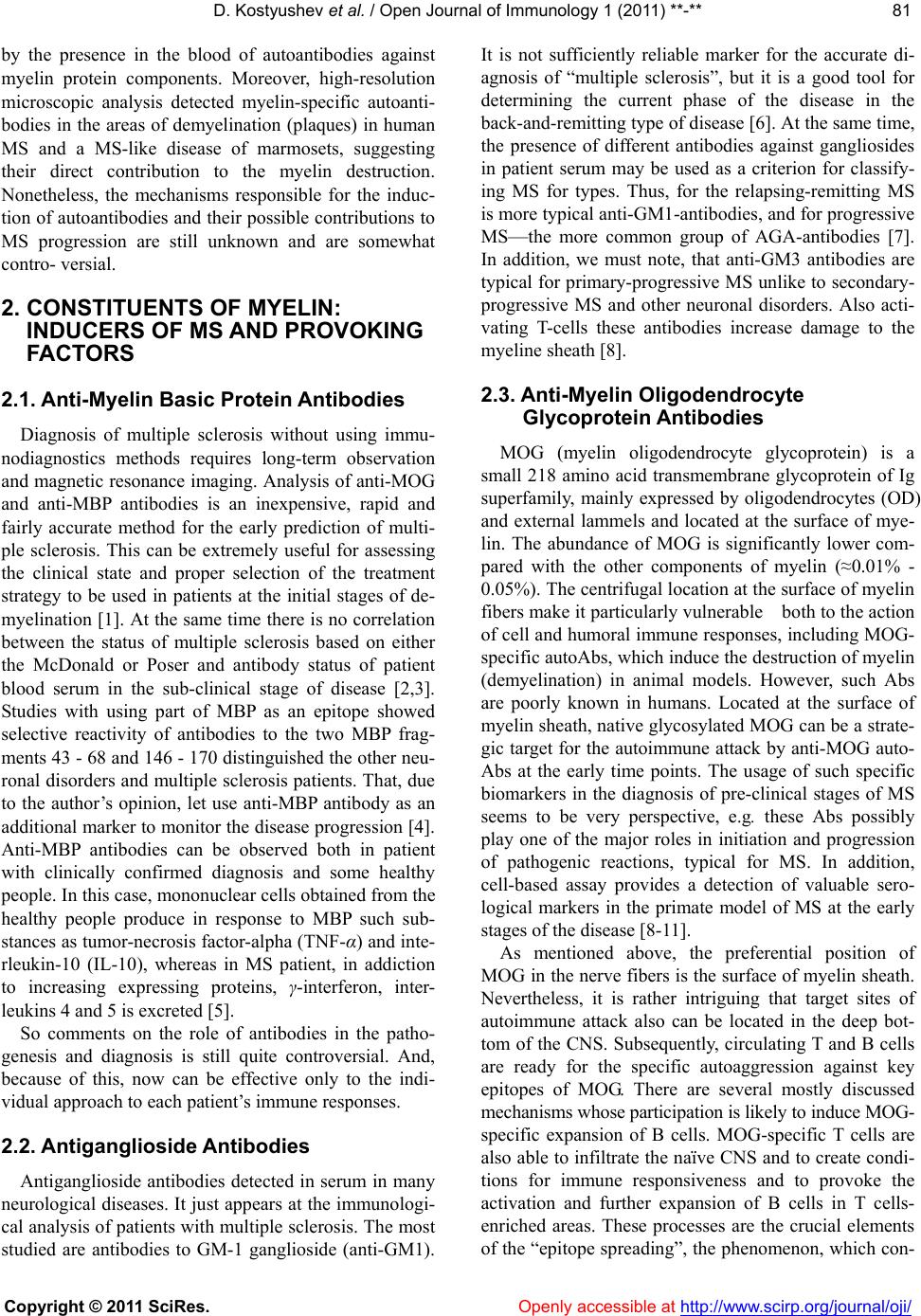 D. Kostyushev et al. / Open Journal of Immunology 1 (2011) **-** Copyright © 2011 SciRes. Openly accessible at http://www.scirp.org/journal/oji/ 8181 by the presence in the blood of autoantibodies against myelin protein components. Moreover, high-resolution microscopic analysis detected myelin-specific autoanti- bodies in the areas of demyelination (plaques) in human MS and a MS-like disease of marmosets, suggesting their direct contribution to the myelin destruction. Nonetheless, the mechanisms responsible for the induc- tion of autoantibodies and their possible contributions to MS progression are still unknown and are somewhat contro- versial. 2. CONSTITUENTS OF MYELIN: INDUCERS OF MS AND PROVOKING FACTORS 2.1. Anti-Myelin Basic Protein Antibodies Diagnosis of multiple sclerosis without using immu- nodiagnostics methods requires long-term observation and magnetic resonance imaging. Analysis of anti-MOG and anti-MBP antibodies is an inexpensive, rapid and fairly accurate method for the early prediction of multi- ple sclerosis. This can be extremely useful for assessing the clinical state and proper selection of the treatment strategy to be used in patients at the initial stages of de- myelination [1]. At the same time there is no correlation between the status of multiple sclerosis based on either the McDonald or Poser and antibody status of patient blood serum in the sub-clinical stage of disease [2,3]. Studies with using part of MBP as an epitope showed selective reactivity of antibodies to the two MBP frag- ments 43 - 68 and 146 - 170 distinguished the other neu- ronal disorders and multiple sclerosis patients. That, due to the author’s opinion, let use anti-MBP antibody as an additional marker to monitor the disease progression [4]. Anti-MBP antibodies can be observed both in patient with clinically confirmed diagnosis and some healthy people. In this case, mononuclear cells obtained from the healthy people produce in response to MBP such sub- stances as tumor-necrosis factor-alpha (TNF-α) and inte- rleukin-10 (IL-10), whereas in MS patient, in addiction to increasing expressing proteins, γ-interferon, inter- leukins 4 and 5 is excreted [5]. So comments on the role of antibodies in the patho- genesis and diagnosis is still quite controversial. And, because of this, now can be effective only to the indi- vidual approach to each patient’s immune responses. 2.2. Antiganglioside Antibodies Antiganglioside antibodies detected in serum in many neurological diseases. It just appears at the immunologi- cal analysis of patients with multiple sclerosis. The most studied are antibodies to GM-1 ganglioside (anti-GM1). It is not sufficiently reliable marker for the accurate di- agnosis of “multiple sclerosis”, but it is a good tool for determining the current phase of the disease in the back-and-remitting type of disease [6]. At the same time, the presence of different antibodies against gangliosides in patient serum may be used as a criterion for classify- ing MS for types. Thus, for the relapsing-remitting MS is more typical anti-GM1-antibodies, and for progressive MS—the more common group of AGA-antibodies [7]. In addition, we must note, that anti-GM3 antibodies are typical for primary-progressive MS unlike to secondary- progressive MS and other neuronal disorders. Also acti- vating T-cells these antibodies increase damage to the myeline sheath [8]. 2.3. Anti-Myelin Oligodendrocyte Glycoprotein Antibodies MOG (myelin oligodendrocyte glycoprotein) is a small 218 amino acid transmembrane glycoprotein of Ig superfamily, mainly expressed by oligodendrocytes (OD) and external lammels and located at the surface of mye- lin. The abundance of MOG is significantly lower com- pared with the other components of myelin (≈0.01% - 0.05%). The centrifugal location at the surface of myelin fibers make it particularly vulnerable both to the action of cell and humoral immune responses, including MOG- specific autoAbs, which induce the destruction of myelin (demyelination) in animal models. However, such Abs are poorly known in humans. Located at the surface of myelin sheath, native glycosylated MOG can be a strate- gic target for the autoimmune attack by anti-MOG auto- Abs at the early time points. The usage of such specific biomarkers in the diagnosis of pre-clinical stages of MS seems to be very perspective, e.g. these Abs possibly play one of the major roles in initiation and progression of pathogenic reactions, typical for MS. In addition, cell-based assay provides a detection of valuable sero- logical markers in the primate model of MS at the early stages of the disease [8-11]. As mentioned above, the preferential position of MOG in the nerve fibers is the surface of myelin sheath. Nevertheless, it is rather intriguing that target sites of autoimmune attack also can be located in the deep bot- tom of the CNS. Subsequently, circulating T and B cells are ready for the specific autoaggression against key epitopes of MOG. There are several mostly discussed mechanisms whose participation is likely to induce MOG- specific expansion of B cells. MOG-specific T cells are also able to infiltrate the naïve CNS and to create condi- tions for immune responsiveness and to provoke the activation and further expansion of B cells in T cells- enriched areas. These processes are the crucial elements of the “epitope spreading”, the phenomenon, which con- 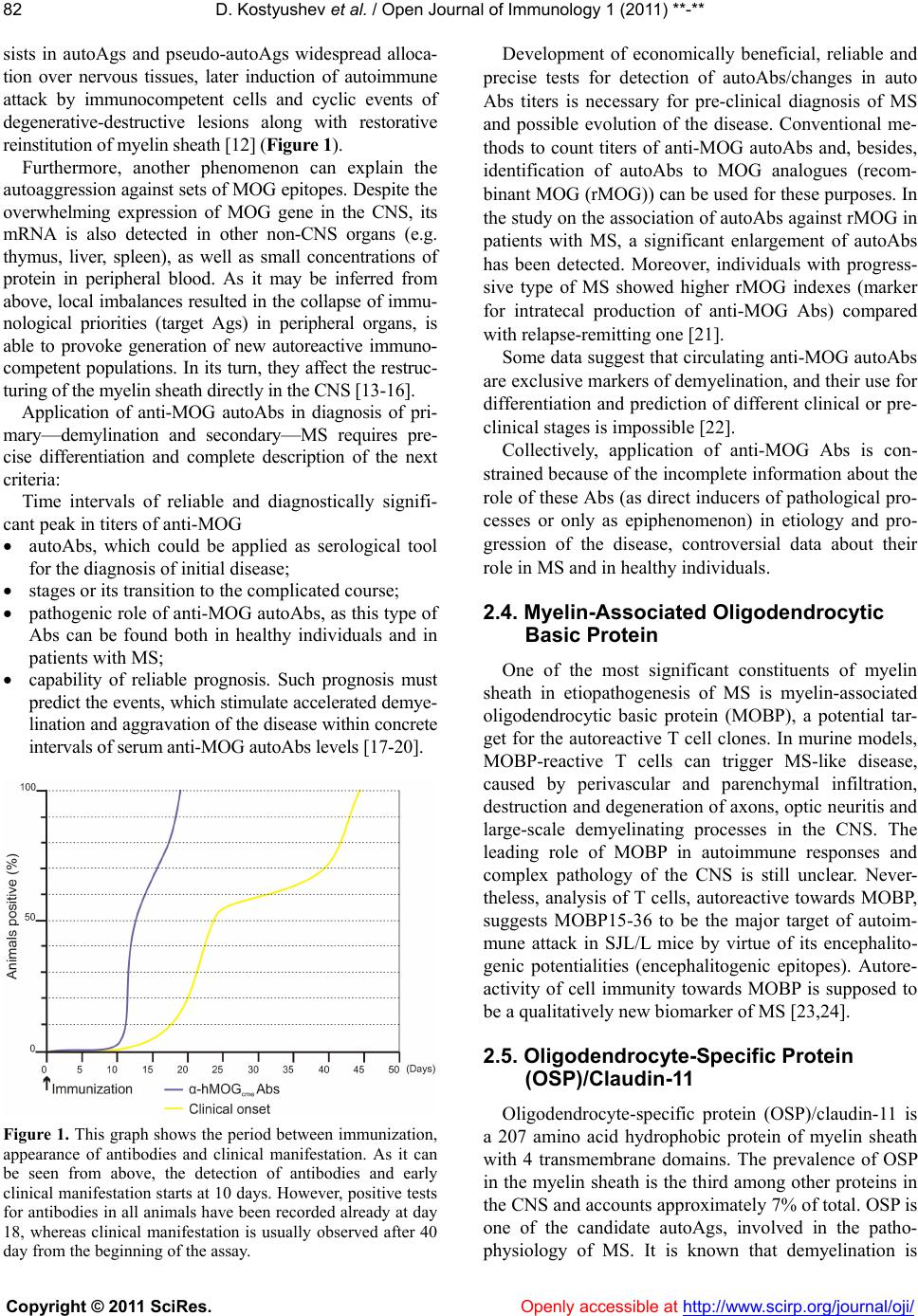 D. Kostyushev et al. / Open Journal of Immunology 1 (2011) **-** Copyright © 2011 SciRes. Openly accessible at http://www.scirp.org/journal/oji/ 82 sists in autoAgs and pseudo-autoAgs widespread alloca- tion over nervous tissues, later induction of autoimmune attack by immunocompetent cells and cyclic events of degenerative-destructive lesions along with restorative reinstitution of myelin sheath [12] (Figure 1). Furthermore, another phenomenon can explain the autoaggression against sets of MOG epitopes. Despite the overwhelming expression of MOG gene in the CNS, its mRNA is also detected in other non-CNS organs (e.g. thymus, liver, spleen), as well as small concentrations of protein in peripheral blood. As it may be inferred from above, local imbalances resulted in the collapse of immu- nological priorities (target Ags) in peripheral organs, is able to provoke generation of new autoreactive immuno- competent populations. In its turn, they affect the restruc- turing of the myelin sheath directly in the CNS [13-16]. Application of anti-MOG autoAbs in diagnosis of pri- mary—demylination and secondary—MS requires pre- cise differentiation and complete description of the next criteria: Time intervals of reliable and diagnostically signifi- cant peak in titers of anti-MOG autoAbs, which could be applied as serological tool for the diagnosis of initial disease; stages or its transition to the complicated course; pathogenic role of anti-MOG autoAbs, as this type of Abs can be found both in healthy individuals and in patients with MS; capability of reliable prognosis. Such prognosis must predict the events, which stimulate accelerated demye- lination and aggravation of the disease within concrete intervals of serum anti-MOG autoAbs levels [17-20]. Figure 1. This graph shows the period between immunization, appearance of antibodies and clinical manifestation. As it can be seen from above, the detection of antibodies and early clinical manifestation starts at 10 days. However, positive tests for antibodies in all animals have been recorded already at day 18, whereas clinical manifestation is usually observed after 40 day from the beginning of the assay. Development of economically beneficial, reliable and precise tests for detection of autoAbs/changes in auto Abs titers is necessary for pre-clinical diagnosis of MS and possible evolution of the disease. Conventional me- thods to count titers of anti-MOG autoAbs and, besides, identification of autoAbs to MOG analogues (recom- binant MOG (rMOG)) can be used for these purposes. In the study on the association of autoAbs against rMOG in patients with MS, a significant enlargement of autoAbs has been detected. Moreover, individuals with progress- sive type of MS showed higher rMOG indexes (marker for intratecal production of anti-MOG Abs) compared with relapse-remitting one [21]. Some data suggest that circulating anti-MOG autoAbs are exclusive markers of demyelination, and their use for differentiation and prediction of different clinical or pre- clinical stages is impossible [22]. Collectively, application of anti-MOG Abs is con- strained because of the incomplete information about the role of these Abs (as direct inducers of pathological pro- cesses or only as epiphenomenon) in etiology and pro- gression of the disease, controversial data about their role in MS and in healthy individuals. 2.4. Myelin-Associated Oligodendrocytic Basic Protein One of the most significant constituents of myelin sheath in etiopathogenesis of MS is myelin-associated oligodendrocytic basic protein (MOBP), a potential tar- get for the autoreactive T cell clones. In murine models, MOBP-reactive T cells can trigger MS-like disease, caused by perivascular and parenchymal infiltration, destruction and degeneration of axons, optic neuritis and large-scale demyelinating processes in the CNS. The leading role of MOBP in autoimmune responses and complex pathology of the CNS is still unclear. Never- theless, analysis of T cells, autoreactive towards MOBP, suggests MOBP15-36 to be the major target of autoim- mune attack in SJL/L mice by virtue of its encephalito- genic potentialities (encephalitogenic epitopes). Autore- activity of cell immunity towards MOBP is supposed to be a qualitatively new biomarker of MS [23,24]. 2.5. Oligodendrocyte-Specific Protein (OSP)/Claudin-11 Oligodendrocyte-specific protein (OSP)/claudin-11 is a 207 amino acid hydrophobic protein of myelin sheath with 4 transmembrane domains. The prevalence of OSP in the myelin sheath is the third among other proteins in the CNS and accounts approximately 7% of total. OSP is one of the candidate autoAgs, involved in the patho- physiology of MS. It is known that demyelination is 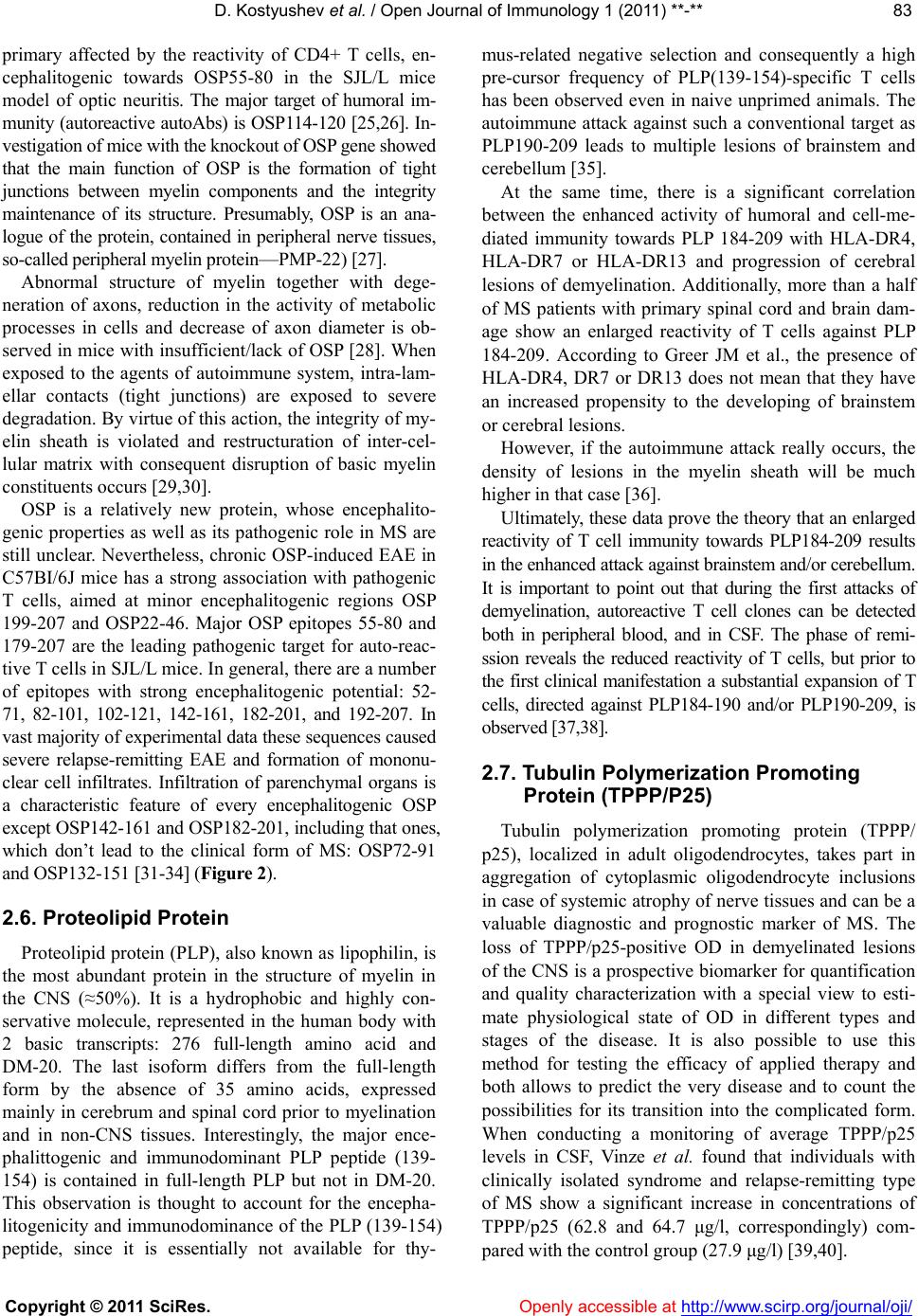 D. Kostyushev et al. / Open Journal of Immunology 1 (2011) **-** Copyright © 2011 SciRes. Openly accessible at http://www.scirp.org/journal/oji/ 8383 primary affected by the reactivity of CD4+ T cells, en- cephalitogenic towards OSP55-80 in the SJL/L mice model of optic neuritis. The major target of humoral im- munity (autoreactive autoAbs) is OSP114-120 [25,26]. In- vestigation of mice with the knockout of OSP gene showed that the main function of OSP is the formation of tight junctions between myelin components and the integrity maintenance of its structure. Presumably, OSP is an ana- logue of the protein, contained in peripheral nerve tissues, so-called peripheral myelin protein—PMP-22) [27]. Abnormal structure of myelin together with dege- neration of axons, reduction in the activity of metabolic processes in cells and decrease of axon diameter is ob- served in mice with insufficient/lack of OSP [28]. When exposed to the agents of autoimmune system, intra-lam- ellar contacts (tight junctions) are exposed to severe degradation. By virtue of this action, the integrity of my- elin sheath is violated and restructuration of inter-cel- lular matrix with consequent disruption of basic myelin constituents occurs [29,30]. OSP is a relatively new protein, whose encephalito- genic properties as well as its pathogenic role in MS are still unclear. Nevertheless, chronic OSP-induced EAE in C57BI/6J mice has a strong association with pathogenic T cells, aimed at minor encephalitogenic regions OSP 199-207 and OSP22-46. Major OSP epitopes 55-80 and 179-207 are the leading pathogenic target for auto-reac- tive T cells in SJL/L mice. In general, there are a number of epitopes with strong encephalitogenic potential: 52- 71, 82-101, 102-121, 142-161, 182-201, and 192-207. In vast majority of experimental data these sequences caused severe relapse-remitting EAE and formation of mononu- clear cell infiltrates. Infiltration of parenchymal organs is a characteristic feature of every encephalitogenic OSP except OSP142-161 and OSP182-201, including that ones, which don’t lead to the clinical form of MS: OSP72-91 and OSP132-151 [31-34] (Figure 2). 2.6. Proteolipid Protein Proteolipid protein (PLP), also known as lipophilin, is the most abundant protein in the structure of myelin in the CNS (≈50%). It is a hydrophobic and highly con- servative molecule, represented in the human body with 2 basic transcripts: 276 full-length amino acid and DM-20. The last isoform differs from the full-length form by the absence of 35 amino acids, expressed mainly in cerebrum and spinal cord prior to myelination and in non-CNS tissues. Interestingly, the major ence- phalittogenic and immunodominant PLP peptide (139- 154) is contained in full-length PLP but not in DM-20. This observation is thought to account for the encepha- litogenicity and immunodominance of the PLP (139-154) peptide, since it is essentially not available for thy- mus-related negative selection and consequently a high pre-cursor frequency of PLP(139-154)-specific T cells has been observed even in naive unprimed animals. The autoimmune attack against such a conventional target as PLP190-209 leads to multiple lesions of brainstem and cerebellum [35]. At the same time, there is a significant correlation between the enhanced activity of humoral and cell-me- diated immunity towards PLP 184-209 with HLA-DR4, HLA-DR7 or HLA-DR13 and progression of cerebral lesions of demyelination. Additionally, more than a half of MS patients with primary spinal cord and brain dam- age show an enlarged reactivity of T cells against PLP 184-209. According to Greer JM et al., the presence of HLA-DR4, DR7 or DR13 does not mean that they have an increased propensity to the developing of brainstem or cerebral lesions. However, if the autoimmune attack really occurs, the density of lesions in the myelin sheath will be much higher in that case [36]. Ultimately, these data prove the theory that an enlarged reactivity of T cell immunity towards PLP184-209 results in the enhanced attack against brainstem and/or cerebellum. It is important to point out that during the first attacks of demyelination, autoreactive T cell clones can be detected both in peripheral blood, and in CSF. The phase of remi- ssion reveals the reduced reactivity of T cells, but prior to the first clinical manifestation a substantial expansion of T cells, directed against PLP184-190 and/or PLP190-209, is observed [37,38]. 2.7. Tubulin Polymerization Promoting Protein (TPPP/P25) Tubulin polymerization promoting protein (TPPP/ p25), localized in adult oligodendrocytes, takes part in aggregation of cytoplasmic oligodendrocyte inclusions in case of systemic atrophy of nerve tissues and can be a valuable diagnostic and prognostic marker of MS. The loss of TPPP/p25-positive OD in demyelinated lesions of the CNS is a prospective biomarker for quantification and quality characterization with a special view to esti- mate physiological state of OD in different types and stages of the disease. It is also possible to use this method for testing the efficacy of applied therapy and both allows to predict the very disease and to count the possibilities for its transition into the complicated form. When conducting a monitoring of average TPPP/p25 levels in CSF, Vinze et al. found that individuals with clinically isolated syndrome and relapse-remitting type of MS show a significant increase in concentrations of TPPP/p25 (62.8 and 64.7 μg/l, correspondingly) com- pared with the control group (27.9 μg/l) [39,40].  D. Kostyushev et al. / Open Journal of Immunology 1 (2011) **-** Copyright © 2011 SciRes. http://www.scirp.org/journal/oji/ 84 Figure 2. T cell proliferative recall responses to OSP peptides in SJL mice immunized with indi- vidual OSP peptides. Spleen cell proliferation assays were performed on one mouse from each group on days 30, 36, 42, and 48 post-injection. OSP peptides were added to a final concentration in culture of 5, 20, and 40 µg/ml. The best SIs were obtained at 20 or 40 µg/ml. The PLP139-151 peptide was used at approximate molar equivalences. The highest SI obtained for each individual mouse’s spleen cells cultured at 4 × 106 and 2 × 106 cells/ml is plotted of adjacent like-patterned bars. The red/yellow/grey/orange part of each bar represents the smallest SI obtained from the OSP peptide titration at 4 × 106 cells/ml or 2 × 106 cells/ml. The green part of bar submit how much SI at 4 × 106 more than 2 × 106, or blue part when SI at 2 × 106 more than 4 × 106. 3. CONCLUSIONS valuable tool for detecting of dormant pathological processes in the myelin sheath. Nonetheless, auto-Abs are the key agents involved in the destruction and de- generation of myelin in the CNS and expansion of autoimmune responses, e.g. pro-inflammotary agression and epitope spreading. As it can be inferred from above, Abs by virtue of its peculiar properties, circulate in pe- On the basis of the ample data in conventional Abs- proteases and Abs with functional reserve in diagnosis of minor lesions occurring in MS patients as well as dif- ferentiated diagnosis, we discussed the crucial antigenic targets for autoimmune attack and their prospects as a Openly accessible at 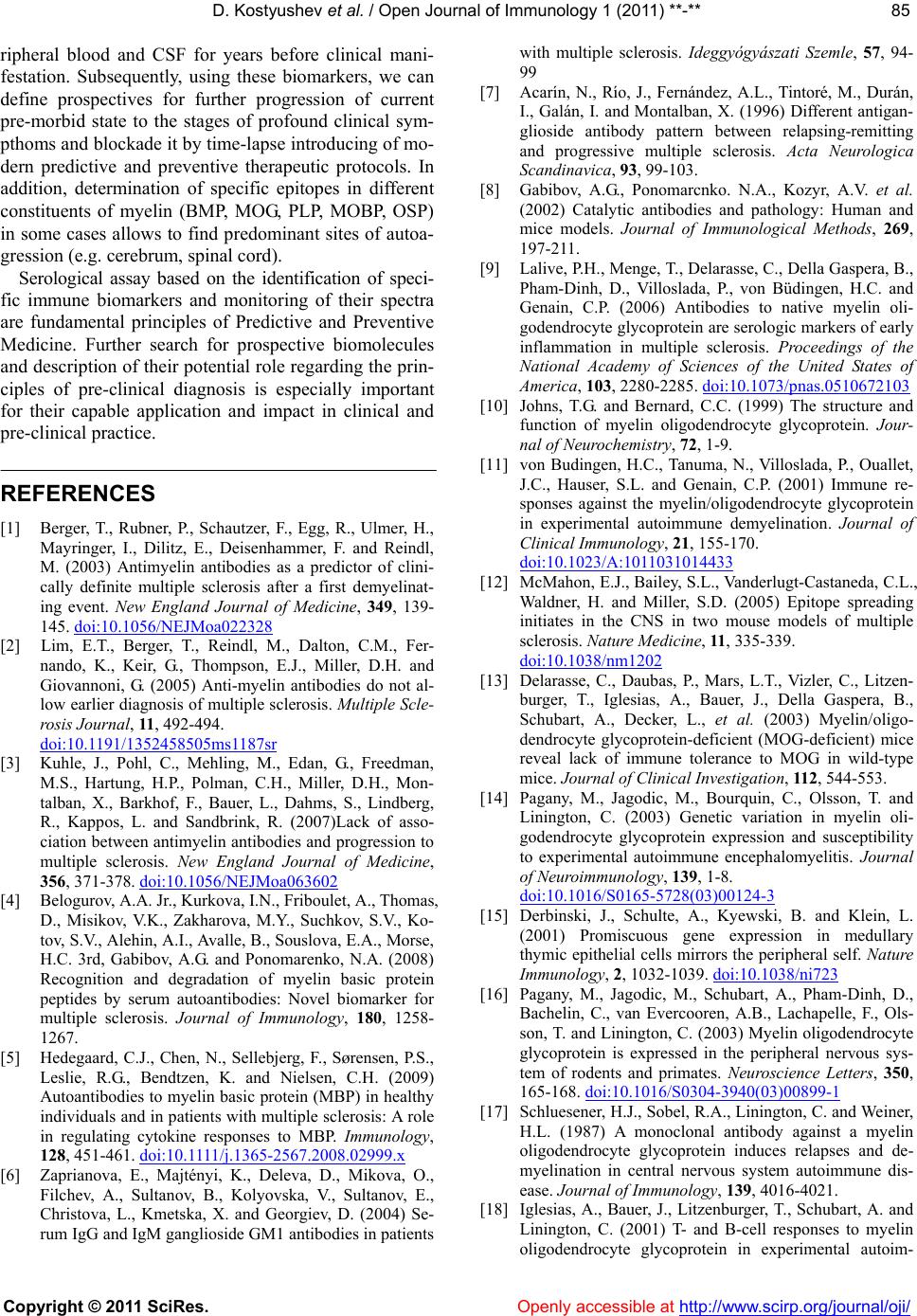 D. Kostyushev et al. / Open Journal of Immunology 1 (2011) **-** Copyright © 2011 SciRes. Openly accessible at http://www.scirp.org/journal/oji/ 8585 ripheral blood and CSF for years before clinical mani- festation. Subsequently, using these biomarkers, we can define prospectives for further progression of current pre-morbid state to the stages of profound clinical sym- pthoms and blockade it by time-lapse introducing of mo- dern predictive and preventive therapeutic protocols. In addition, determination of specific epitopes in different constituents of myelin (BMP, MOG, PLP, MOBP, OSP) in some cases allows to find predominant sites of autoa- gression (e.g. cerebrum, spinal cord). Serological assay based on the identification of speci- fic immune biomarkers and monitoring of their spectra are fundamental principles of Predictive and Preventive Medicine. Further search for prospective biomolecules and description of their potential role regarding the prin- ciples of pre-clinical diagnosis is especially important for their capable application and impact in clinical and pre-clinical practice. REFERENCES [1] Berger, T., Rubner, P., Schautzer, F., Egg, R., Ulmer, H., Mayringer, I., Dilitz, E., Deisenhammer, F. and Reindl, M. (2003) Antimyelin antibodies as a predictor of clini- cally definite multiple sclerosis after a first demyelinat- ing event. New England Journal of Medicine, 349 , 139- 145. doi:10.1056/NEJMoa022328 [2] Lim, E.T., Berger, T., Reindl, M., Dalton, C.M., Fer- nando, K., Keir, G., Thompson, E.J., Miller, D.H. and Giovannoni, G. (2005) Anti-myelin antibodies do not al- low earlier diagnosis of multiple sclerosis. Multiple Scle- rosis Journal, 11, 492-494. doi:10.1191/1352458505ms1187sr [3] Kuhle, J., Pohl, C., Mehling, M., Edan, G., Freedman, M.S., Hartung, H.P., Polman, C.H., Miller, D.H., Mon- talban, X., Barkhof, F., Bauer, L., Dahms, S., Lindberg, R., Kappos, L. and Sandbrink, R. (2007)Lack of asso- ciation between antimyelin antibodies and progression to multiple sclerosis. New England Journal of Medicine, 356, 371-378. doi:10.1056/NEJMoa063602 [4] Belogurov, A.A. Jr., Kurkova, I.N., Friboulet, A., Thomas, D., Misikov, V.K., Zakharova, M.Y., Suchkov, S.V., Ko- tov, S.V., Alehin, A.I., Avalle, B., Souslova, E.A., Morse, H.C. 3rd, Gabibov, A.G. and Ponomarenko, N.A. (2008) Recognition and degradation of myelin basic protein peptides by serum autoantibodies: Novel biomarker for multiple sclerosis. Journal of Immunology, 180, 1258- 1267. [5] Hedegaard, C.J., Chen, N., Sellebjerg, F., Sørensen, P.S., Leslie, R.G., Bendtzen, K. and Nielsen, C.H. (2009) Autoantibodies to myelin basic protein (MBP) in healthy individuals and in patients with multiple sclerosis: A role in regulating cytokine responses to MBP. Immunology, 128, 451-461. doi:10.1111/j.1365-2567.2008.02999.x [6] Zaprianova, E., Majtényi, K., Deleva, D., Mikova, O., Filchev, A., Sultanov, B., Kolyovska, V., Sultanov, E., Christova, L., Kmetska, X. and Georgiev, D. (2004) Se- rum IgG and IgM ganglioside GM1 antibodies in patients with multiple sclerosis. Ideggyógyászati Szemle, 57, 94- 99 [7] Acarín, N., Río, J., Fernández, A.L., Tintoré, M., Durán, I., Galán, I. and Montalban, X. (1996) Different antigan- glioside antibody pattern between relapsing-remitting and progressive multiple sclerosis. Acta Neurologica Scandinavica, 93, 99-103. [8] Gabibov, A.G., Ponomarcnko. N.A., Kozyr, A.V. et al. (2002) Catalytic antibodies and pathology: Human and mice models. Journal of Immunological Methods, 269, 197-211. [9] Lalive, P.H., Menge, T., Delarasse, C., Della Gaspera, B., Pham-Dinh, D., Villoslada, P., von Büdingen, H.C. and Genain, C.P. (2006) Antibodies to native myelin oli- godendrocyte glycoprotein are serologic markers of early inflammation in multiple sclerosis. Proceedings of the National Academy of Sciences of the United States of America, 103, 2280-2285. doi:10.1073/pnas.0510672103 [10] Johns, T.G. and Bernard, C.C. (1999) The structure and function of myelin oligodendrocyte glycoprotein. Jour- nal of Neurochemistry, 72, 1-9. [11] von Budingen, H.C., Tanuma, N., Villoslada, P., Ouallet, J.C., Hauser, S.L. and Genain, C.P. (2001) Immune re- sponses against the myelin/oligodendrocyte glycoprotein in experimental autoimmune demyelination. Journal of Clinical Immunology, 21, 155-170. doi:10.1023/A:1011031014433 [12] McMahon, E.J., Bailey, S.L., Vanderlugt-Castaneda, C.L., Waldner, H. and Miller, S.D. (2005) Epitope spreading initiates in the CNS in two mouse models of multiple sclerosis. Nature Medicine, 11, 335-339. doi:10.1038/nm1202 [13] Delarasse, C., Daubas, P., Mars, L.T., Vizler, C., Litzen- burger, T., Iglesias, A., Bauer, J., Della Gaspera, B., Schubart, A., Decker, L., et al. (2003) Myelin/oligo- dendrocyte glycoprotein-deficient (MOG-deficient) mice reveal lack of immune tolerance to MOG in wild-type mice. Journal of Clinical Investigation, 112, 544-553. [14] Pagany, M., Jagodic, M., Bourquin, C., Olsson, T. and Linington, C. (2003) Genetic variation in myelin oli- godendrocyte glycoprotein expression and susceptibility to experimental autoimmune encephalomyelitis. Journal of Neuroimmunology, 139, 1-8. doi:10.1016/S0165-5728(03)00124-3 [15] Derbinski, J., Schulte, A., Kyewski, B. and Klein, L. (2001) Promiscuous gene expression in medullary thymic epithelial cells mirrors the peripheral self. Nature Immunology, 2, 1032-1039. doi:10.1038/ni723 [16] Pagany, M., Jagodic, M., Schubart, A., Pham-Dinh, D., Bachelin, C., van Evercooren, A.B., Lachapelle, F., Ols- son, T. and Linington, C. (2003) Myelin oligodendrocyte glycoprotein is expressed in the peripheral nervous sys- tem of rodents and primates. Neuroscience Letters, 350, 165-168. doi:10.1016/S0304-3940(03)00899-1 [17] Schluesener, H.J., Sobel, R.A., Linington, C. and Weiner, H.L. (1987) A monoclonal antibody against a myelin oligodendrocyte glycoprotein induces relapses and de- myelination in central nervous system autoimmune dis- ease. Journal of Immunology, 139, 4016-4021. [18] Iglesias, A., Bauer, J., Litzenburger, T., Schubart, A. and Linington, C. (2001) T- and B-cell responses to myelin oligodendrocyte glycoprotein in experimental autoim- 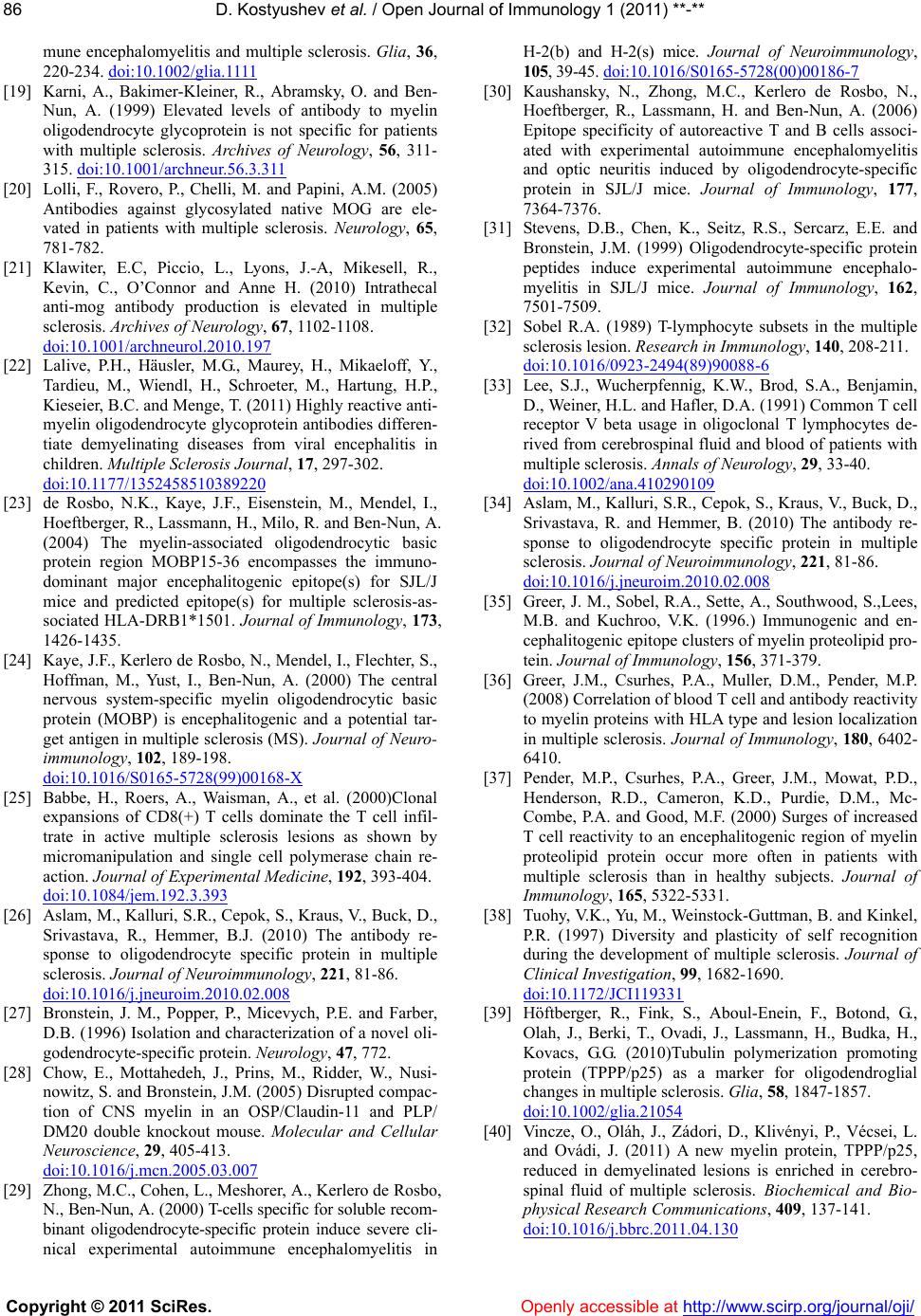 D. Kostyushev et al. / Open Journal of Immunology 1 (2011) **-** Copyright © 2011 SciRes. http://www.scirp.org/journal/oji/Openly accessible at 86 mune encephalomyelitis and multiple sclerosis. Glia, 36, 220-234. doi:10.1002/glia.1111 [19] Karni, A., Bakimer-Kleiner, R., Abramsky, O. and Ben- Nun, A. (1999) Elevated levels of antibody to myelin oligodendrocyte glycoprotein is not specific for patients with multiple sclerosis. Archives of Neurology, 56, 311- 315. doi:10.1001/archneur.56.3.311 [20] Lolli, F., Rovero, P., Chelli, M. and Papini, A.M. (2005) Antibodies against glycosylated native MOG are ele- vated in patients with multiple sclerosis. Neurology, 65, 781-782. [21] Klawiter, E.C, Piccio, L., Lyons, J.-A, Mikesell, R., Kevin, C., O’Connor and Anne H. (2010) Intrathecal anti-mog antibody production is elevated in multiple sclerosis. Archives of Neurology, 67, 1102-1108. doi:10.1001/archneurol.2010.197 [22] Lalive, P.H., Häusler, M.G., Maurey, H., Mikaeloff, Y., Tardieu, M., Wiendl, H., Schroeter, M., Hartung, H.P., Kieseier, B.C. and Menge, T. (2011) Highly reactive anti- myelin oligodendrocyte glycoprotein antibodies differen- tiate demyelinating diseases from viral encephalitis in children. Multiple Sclerosis Journal, 17, 297-302. doi:10.1177/1352458510389220 [23] de Rosbo, N.K., Kaye, J.F., Eisenstein, M., Mendel, I., Hoeftberger, R., Lassmann, H., Milo, R. and Ben-Nun, A. (2004) The myelin-associated oligodendrocytic basic protein region MOBP15-36 encompasses the immuno- dominant major encephalitogenic epitope(s) for SJL/J mice and predicted epitope(s) for multiple sclerosis-as- sociated HLA-DRB1*1501. Journal of Immunology, 173, 1426-1435. [24] Kaye, J.F., Kerlero de Rosbo, N., Mendel, I., Flechter, S., Hoffman, M., Yust, I., Ben-Nun, A. (2000) The central nervous system-specific myelin oligodendrocytic basic protein (MOBP) is encephalitogenic and a potential tar- get antigen in multiple sclerosis (MS). Journal of Neuro- immunology, 102, 189-198. doi:10.1016/S0165-5728(99)00168-X [25] Babbe, H., Roers, A., Waisman, A., et al. (2000)Clonal expansions of CD8(+) T cells dominate the T cell infil- trate in active multiple sclerosis lesions as shown by micromanipulation and single cell polymerase chain re- action. Journal of Experimental Medicine, 192, 393-404. doi:10.1084/jem.192.3.393 [26] Aslam, M., Kalluri, S.R., Cepok, S., Kraus, V., Buck, D., Srivastava, R., Hemmer, B.J. (2010) The antibody re- sponse to oligodendrocyte specific protein in multiple sclerosis. Journal of Neuroimmunology, 221, 81-86. doi:10.1016/j.jneuroim.2010.02.008 [27] Bronstein, J. M., Popper, P., Micevych, P.E. and Farber, D.B. (1996) Isolation and characterization of a novel oli- godendrocyte-specific protein. Neurology, 47, 772. [28] Chow, E., Mottahedeh, J., Prins, M., Ridder, W., Nusi- nowitz, S. and Bronstein, J.M. (2005) Disrupted compac- tion of CNS myelin in an OSP/Claudin-11 and PLP/ DM20 double knockout mouse. Molecular and Cellular Neuroscience, 29, 405-413. doi:10.1016/j.mcn.2005.03.007 [29] Zhong, M.C., Cohen, L., Meshorer, A., Kerlero de Rosbo, N., Ben-Nun, A. (2000) T-cells specific for soluble recom- binant oligodendrocyte-specific protein induce severe cli- nical experimental autoimmune encephalomyelitis in H-2(b) and H-2(s) mice. Journal of Neuroimmunology, 105, 39-45. doi:10.1016/S0165-5728(00)00186-7 [30] Kaushansky, N., Zhong, M.C., Kerlero de Rosbo, N., Hoeftberger, R., Lassmann, H. and Ben-Nun, A. (2006) Epitope specificity of autoreactive T and B cells associ- ated with experimental autoimmune encephalomyelitis and optic neuritis induced by oligodendrocyte-specific protein in SJL/J mice. Journal of Immunology, 177, 7364-7376. [31] Stevens, D.B., Chen, K., Seitz, R.S., Sercarz, E.E. and Bronstein, J.M. (1999) Oligodendrocyte-specific protein peptides induce experimental autoimmune encephalo- myelitis in SJL/J mice. Journal of Immunology, 162, 7501-7509. [32] Sobel R.A. (1989) T-lymphocyte subsets in the multiple sclerosis lesion. Research in Immunology, 140, 208-211. doi:10.1016/0923-2494(89)90088-6 [33] Lee, S.J., Wucherpfennig, K.W., Brod, S.A., Benjamin, D., Weiner, H.L. and Hafler, D.A. (1991) Common T cell receptor V beta usage in oligoclonal T lymphocytes de- rived from cerebrospinal fluid and blood of patients with multiple sclerosis. Annals of Neurology, 29, 33-40. doi:10.1002/ana.410290109 [34] Aslam, M., Kalluri, S.R., Cepok, S., Kraus, V., Buck, D., Srivastava, R. and Hemmer, B. (2010) The antibody re- sponse to oligodendrocyte specific protein in multiple sclerosis. Journal of Neuroimmunology, 221, 81-86. doi:10.1016/j.jneuroim.2010.02.008 [35] Greer, J. M., Sobel, R.A., Sette, A., Southwood, S.,Lees, M.B. and Kuchroo, V.K. (1996.) Immunogenic and en- cephalitogenic epitope clusters of myelin proteolipid pro- tein. Journal of Immunology, 156, 371-379. [36] Greer, J.M., Csurhes, P.A., Muller, D.M., Pender, M.P. (2008) Correlation of blood T cell and antibody reactivity to myelin proteins with HLA type and lesion localization in multiple sclerosis. Journal of Immunology, 180, 6402- 6410. [37] Pender, M.P., Csurhes, P.A., Greer, J.M., Mowat, P.D., Henderson, R.D., Cameron, K.D., Purdie, D.M., Mc- Combe, P.A. and Good, M.F. (2000) Surges of increased T cell reactivity to an encephalitogenic region of myelin proteolipid protein occur more often in patients with multiple sclerosis than in healthy subjects. Journal of Immunology, 165, 5322-5331. [38] Tuohy, V.K., Yu, M., Weinstock-Guttman, B. and Kinkel, P.R. (1997) Diversity and plasticity of self recognition during the development of multiple sclerosis. Journal of Clinical Investigation, 99, 1682-1690. doi:10.1172/JCI119331 [39] Höftberger, R., Fink, S., Aboul-Enein, F., Botond, G., Olah, J., Berki, T., Ovadi, J., Lassmann, H., Budka, H., Kovacs, G.G. (2010)Tubulin polymerization promoting protein (TPPP/p25) as a marker for oligodendroglial changes in multiple sclerosis. Glia, 58, 1847-1857. doi:10.1002/glia.21054 [40] Vincze, O., Oláh, J., Zádori, D., Klivényi, P., Vécsei, L. and Ovádi, J. (2011) A new myelin protein, TPPP/p25, reduced in demyelinated lesions is enriched in cerebro- spinal fluid of multiple sclerosis. Biochemical and Bio- physical Research Communications, 409, 137-141. doi:10.1016/j.bbrc.2011.04.130
|